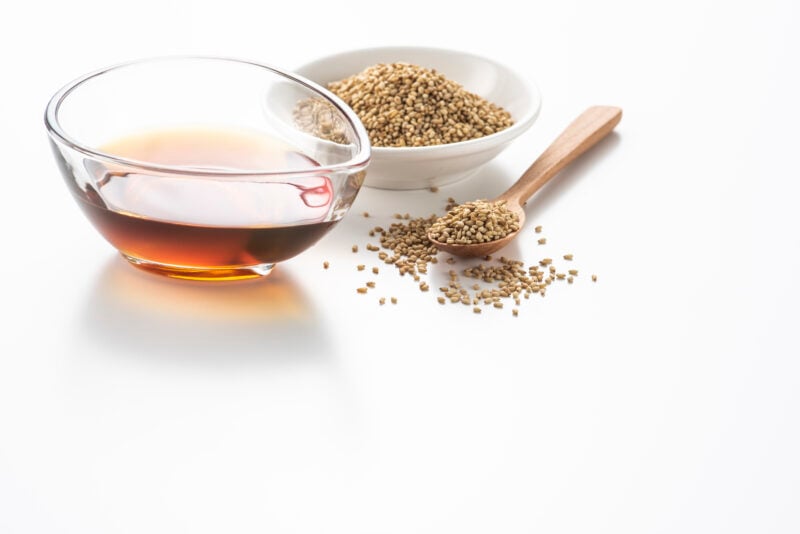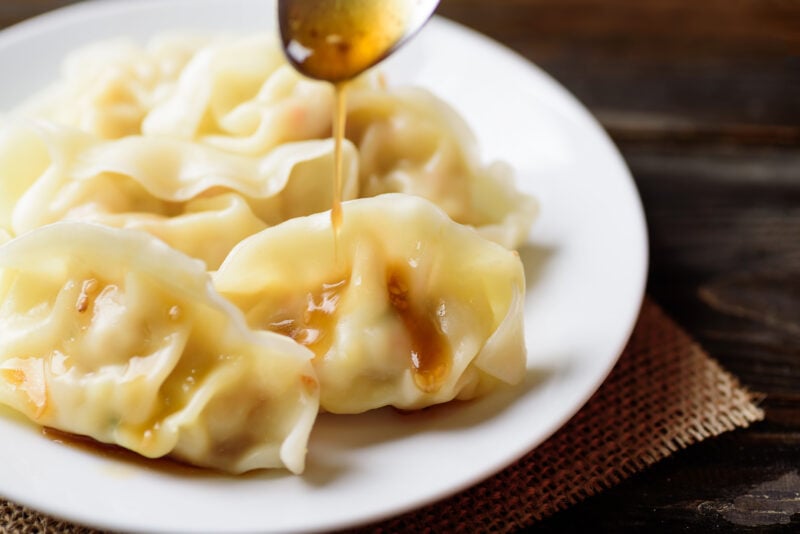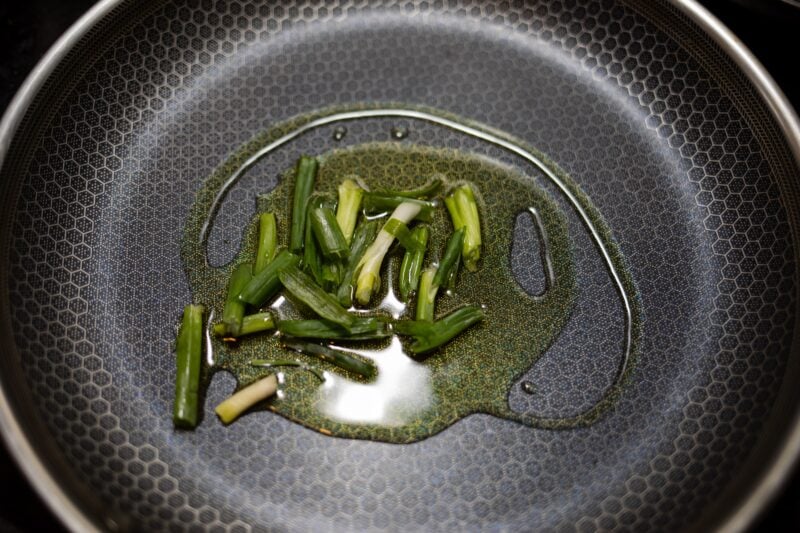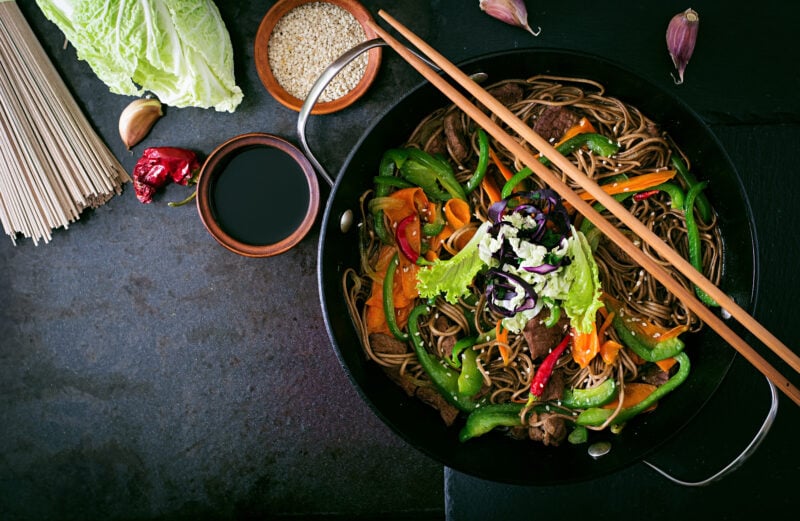Sesame Oil Uses and Substitutions
- By Amy Dong
- Updated May. 22, 2025
Asian recipes often incorporate sesame oil in sauces, dressings, and quick stir fry dishes. It’s a pantry ingredient that adds fragrant aroma and depth of flavor. It can be used in Chinese, Japanese, Korean recipes, and more.

What is Sesame Oil?
Sesame seed oil is an oil that’s made from pure sesame seeds. It can be toasted or non-toasted, and there are distinct differences between the two varieties. Toasted sesame oil is darker in color and boasts a rich, nutty, and toasted flavor. Non-toasted, raw sesame oil has a light color and has neutral flavor.
Toasted Sesame Oil vs. Non-Toasted Sesame Oil
You’ll be able to tell the difference between toasted and un-toasted sesame oils from the color. Dark, caramel-colored sesame oil is toasted, while the light golden-colored variety is not. When you see a recipe that calls for toasted sesame oil, you know that it’s being used to add a more earthy and nutty flavor to whatever you’re cooking. Remember: the two are generally not interchangeable.
In addition, there are even lightly toasted sesame oils to choose from. These will boast a milder toasted flavor and are still considered different from non-toasted.
Most Asian-inspired recipes will call for toasted sesame oil. It can quickly change the taste of your dishes and give them a recognizable sesame flavor which is synonymous with Asian cooking!
What Does Sesame Oil Taste Like?
Toasted sesame oil has a wonderfully aromatic, deep, nutty flavor that is classic in Asian dressings and sauces. Regular, un-toasted sesame oil is mild, light, and non-distinct in taste.

Sesame Oil vs. Olive Oil
The sesame oil vs. olive oil debate comes up often in cooking as they are both considered on the healthier side. However, they aren’t that similar. It’s no secret that sesame seed oil is made from sesame seeds and olive oil is made from olives. There is indeed a huge difference in flavor. Sesame oil is nutty and earthy and olive oil is fruity and slightly bitter.
Toasted sesame oil has a much stronger flavor than olive oil and can quickly overtake a dish if you’re not careful about the quantity you use.
You can use both olive oil and sesame oil as a seasoning in salads and sauces. In terms of other uses, olive oil is more versatile than sesame. It can be used as cooking oil, as a seasoning, and in baking. There are also many more varieties of olive oil than sesame.
That said, in your Asian-inspired recipes, toasted sesame oil is always preferred!

Sesame Oil Uses
It’s important to think of toasted sesame oil as a seasoning instead of cooking oil. It can add a finishing touch to many different recipes and should be added in the last cooking stage. Toasted sesame oil is better used in marinades, salad dressings, or sauces.
It works wonderfully in balancing out other flavors like spices or vinegar. You don’t need to add a lot to get that nutty flavor you’re after, so use it sparingly.
Un-toasted sesame seed oil is sometimes used on hair and skin, like olive oil. You can also use it for cooking as you would any other type of light vegetable oil.
Sesame Oil Benefits
Sesame oil benefits are many! It is high in healthy-for-your-heart fats and contains vitamins E and K. It also contains good fatty acids like omega-3, omega-6, and omega-9. These things are shown to improve your heart health when combined with a healthy diet and exercise.
You can also use non-toasted sesame seed oil to nourish your skin and your hair, thanks to vitamin E.

Sesame Oil Smoke Point
Non-toasted Sesame oil has a smoke point of 410°F, which is a high smoke point compared to other oils. It’s a practical choice for cooking, stir frying, and sautéeing.
It’s not recommended that you cook with toasted sesame oil. It has a lower smoke point of about 350°F, so it burns more easily. Save it for seasoning!
How Long Does Sesame Oil Keep?
Like all oils, sesame oil can become less fresh and rancid over time.
- Shelf life: About 6–12 months after opening any type of sesame oil.
- Storage: Keep it in a cool, dark place, or refrigerate to extend shelf life.
Sesame Oil Substitutions
Replace untoasted sesame oil with:
- Peanut oil
- Canola oil
- Sunflower seed oil
- Olive oil
Replace toasted Asian sesame oil with:
- Chinese sesame paste – this will be stronger in flavor than the oil, so use less of it than you would the oil.
- Tahini – this is made with ground sesame seeds, with outer hull removed.
- Roasted peanut oil – though this has a different flavor profile, it can be used as a substitution if needed. Keep in mind that peanut oil is not nearly as fragrant as Asian sesame oil is.
- Toasted sesame seeds – if you don’t have sesame oil yet still want sesame flavor, feel free to sprinkle in plenty of sesame seeds in place of the oil. However, you’ll still want to use another oil replacement if you’re using it for cooking, sauces, or dressings.

Recipes That Use Sesame Oil
Sesame oil recipes are endless! As mentioned, the different varieties can be used in a variety of ways. Here are some sesame oil recipes that you can try at home:
- Lo mein noodles (easy meal prep)
- Hawaiian BBQ grilled chicken
- Asian cold sesame noodles (nut free)
- Spicy Thai peanut noodles
- 15-minute ginger soy Asian steamed fish
- Pot stickers (Asian dumplings)
- Healthy poke bowls (with Sriracha mayo)
Can I Substitute Toasted Sesame Oil for Un-toasted Sesame Oil?
Because untoasted sesame oil has a much higher smoke point than toasted, they can’t be easily substituted for one another. Toasted sesame oil will burn if you try to use it as a cooking oil. You can use both varieties as a finisher for sauces or salads, but keep in mind that toasted has a much more distinct sesame flavor and is highly aromatic.
Can I Use Coconut Oil Instead of Sesame Oil?
While coconut oil isn’t the number one sesame oil substitute option, they can be subbed in for each other. That said, this is only for recipes that call for untoasted sesame oil. And, it’s also important to note that coconut oil will give your recipes a slight coconut flavor.
What Is The Best Oil For Stir-Fry?
Canola oil one of the most common choices of oil to use for stir-fries. Nonetheless, you can opt to use un-toasted sesame oil instead. It will lend a very slight sesame taste to whatever you’re cooking. When you add toasted varieties as a finishing touch, can add much to your Asian-inspired dishes.
Delicious Asian Recipes To Try
- Chinese Chicken Salad – a fresh homemade take on a restaurant favorite.
- Marinated Seared Ahi Tuna – a flavorful, refreshing, and unique appetizer or side dish option.
- Hurts So Good Chicken Recipe – you’ll want to eat this crunchy chicken recipe until it hurts!
- Garlic Soy Braised Chicken – filling and hearty comfort food at its best!
